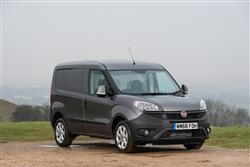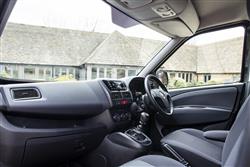DOB'S THE JOB? (some text hidden) --NONE--
By Jonathan Crouch
Introductionword count: 59
Fiat's Doblo Cargo van finally realised its potential in second generation guise. Pitched against the largest compact vans you can buy, it's hard to better when it comes to value, practicality and low running costs. And it looks quite smart too. Canny business buyers in search of a small van from the 2010-2022 era can't afford to ignore it.
Modelsword count: 10
Light panel van (1.3, 1.6, 2.0 diesel / 1.4 petrol])
Historyword count: 156
Compact vans from the 21st century's second decade come in all shapes and sizes. This one though, Fiat's second generation Doblo Cargo, came in more shapes and sizes than most, one of the few small vans of its era to be offered with a high roof option. The original curiously-styled pre-2010-era version of this model offered little you couldn't get elsewhere from Citroen Berlingo and Peugeot Partner-class vehicles, nor did it have the kind of high-roof, extended wheelbase option that would make it a realistic compact alternative to something Transit-sized. All that though, was put right in a second generation model that turned out to be 95% all new and which was able from launch to beat most of its contemporaries in payload, load volume and running costs - in other words, all the things that really matter. It sold all the way to 2022, when it was finally replaced by a shared Stellantis Group design.
What You Getword count: 663
Styling is not high on the priority list for many potential van purchasers, but even so, the looks of the original pre-2010 first generation Doblo Cargo model did put a few businesses off. That MK1 version quickly got a smarter front end but it was only with the introduction of this MK2 model that this Fiat really got an appearance that could hope to gain universal acceptance. So how did the Italians do it? Well, the A-pillars are blacked-out to create a visor effect that merges the van's windscreen and side windows. Thick bumpers are employed at both ends for added protection and large wheel arches bulge from the flanks. Inside the smart cabin, there's was a two-tone colour option which when fitted breaks up all the grey plastic. Much of the switchgear is straight from Fiat passenger cars, with the stereo in particular adding a passenger car-like touch. There's no optional small centre seat of the kind that some rivals from this period offer but otherwise, the interior is hard to fault. The plastics are sturdy and the gear lever is mounted high-up within easy reach of the well-shaped height (but not reach) adjustable steering wheel. Though there's a general absence of cupholders, in-cab storage is otherwise pretty good with a tray under the passenger seat, a glovebox capable of swallowing a 14-inch laptop and a bin in each door that can take a half-litre bottle of water and an A4 clipboard. There's also a tray on top of the dashboard and a shelf above the windscreen. Onto practicality. The payload and loading volume figures for this van need to be significant enough to persuade buyers to pay the extra over a small van like, say, Fiat's own Fiorino. And of course, they need to out-smart direct larger compact van competitors like Citroen's Berlingo and Peugeot's Partner. The original MK1 Doblo Cargo model couldn't deliver on either of those fronts but this one managed it in style. Even the short wheelbase model can deliver up to 750kgs (nearly 150kg more than something Fiorino or Citroen Nemo-sized), while the long wheelbase Cargo Maxi variant can extend this to a class-leading 1,000kgs, 150kgs more than Peugeot or Citroen rivals. OK, what about that other crucial measurement - load volume? Well, here again, this Doblo is tough to beat. The short wheelbase low roof version delivers 3.4m3, a figure you could boost to 4.0m3 by finding yourself a high roof model, this van being one of the very few available with a high roof option. Go for the long wheelbase Cargo Maxi model and that figure rises to 4.2m, one that no period rival can better. Pull the nice chunky big door handles and they open to reveal an aperture 1231mm wide and either 1250 or 1455mm high, depending on whether you've chosen a standard or high roof model. There's a usefully low rear loading height of 545mm and the redesigned suspension has allowed for a slimmer set of wheel boxes that allow 1230mm of loading width, easily enough for a euro-pallet. Once inside, there's up to 2170mm of loading length, 1550mm in hight and 1714mm of width side-to-side once you get above the wheel boxes. So yes, pretty much everything you'll need to carry will probably fit. A sliding side door didn't come as standard on the entry-level short wheelbase model, but it was an option, with plusher versions and the bigger Cargo Maxi model featuring a sliding door on each side 1175mm high and 700mm wide, again, enough for a euro-pallet. Six floor-mounted load tie-down points will stop your load from moving around, but if you forget to use them and it all slides forward, then you'll be glad that a full-height steel bulkhead was standard. Fiat's designers also copied rivals by developing an optional fold-flat front passenger seat with a mesh bulkhead that swings out of the way so that longer items can be accommodated. Look for models with that feature fitted.
To see the full road test text contact us on 0330 0020 227
Pictures (high res disabled)
.jpg)
.jpg)
|
.jpg)
|
.jpg)
| |||
.jpg)
|
.jpg)
|
.jpg)
| |||

|
.jpg)
|

|
Scoring (subset of scores)
Category: Vans
| Performance | |
| Handling | |
| Comfort | |
| Space | |
| Styling, Build, Value, Equipment, Depreciation, Handling, Insurance and Total scores are available with our full data feed. | |



